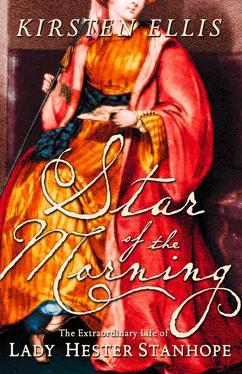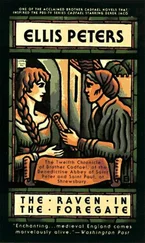On Friday, she wavered from her appointment with death, and sent one of her men down the hill with orders to bring back the first European doctor he could find. She seethed, knowing that an Italian doctor – ‘that useless Lunardi’ – was at that very moment hurrying on his way to return to her service, no doubt hopeful that the fee for this voyage, as well as the large sum owing on his earlier ministrations, would be reimbursed upon his arrival. Unable to eat, and barely sipping water, her coughing became worse, and with each attack, blood poured from her mouth. She acknowledged defeat, too weak even to pull at the hemp rope within her reach, attached by an apparatus of pulleys to a large brass bell. She ordered only that the candles be kept constantly lit in the whitewashed alcove at her bedside, so she could watch the flames. That night the moon and stars were clear, and she could smell the breath of jackals as they prowled beneath her window. Did she fear death then? Many believed her fearless. She believed in the divine, in the transmigration of souls – that she herself was marked for greatness. She had looked death in the face many times, and fancied she could see it written in the faces of men, and so could judge their fate.
Now Lady Hester Stanhope lay dead, and all that she had been was gone. Her garden would be left to run wild – the arbours of yellow jasmine, fountain pavilions and her favourite archways of periwinkle with its bright blue flowers – and her splendid house would be left to rot and crumble, the bricks themselves to melt back into the earth. Her hill would become no more than a place you might climb for a better view of the sea, as it was when she came.
It was not until ten o’clock the next night that two strangers could be seen making their way up the hillside to the house, their torches bobbing like fireflies, their horses stumbling at the steep incline. A guide from the village walked alongside, fearful in the darkness of snakes, wild boar, jackals, wolves and even panthers. The journey had taken the two men more than ten hours of hard riding. It had fallen to the British consul in Beirut, Niven Moore, to investigate the death of Lady Stanhope. She was, after all, granddaughter of the Great Commoner himself and the niece of William Pitt, even if she had placed herself beyond the reach of reasonable society in such curious and remote circumstances. He had asked an American missionary, the Reverend William McClure Thomson, a man well liked by the British community in Beirut, to accompany him and conduct whatever funeral service they could manage. 1
Moore was already well acquainted with the affairs of ‘Her Ladyship’. He was in glum possession of a dispatch box of documents bristling with notarized seals thrust upon him by her numerous creditors. It was said that not only had Lady Hester Stanhope descended from bankruptcy to penury – patronizing moneylenders all the way up the coast from Sidon to Tripoli, with escalating debts in half a dozen currencies – but was now quite mad. Gossip about her was as commonplace in the Beirut souk as in a Bath tearoom. Of all the young Victoria’s subjects in this part of the world, he mused, she was surely one of the most problematic. Or at the very least, notorious.
Nothing had deterred her, not travelling at sea during the Napoleonic wars, not riding through deserts of warring Bedouin, nor the threat of assassination during civil war in Syria, a semi-barbarous country at the best of times. Who could resist speculating about the lovers she had entertained in her fairytale fortress, about the way she presided like a chieftain over her raggle-taggle band of servants, about what fate befell those whose throats she had threatened to have cut, in her make-believe kingdom, with its dungeons and secret passages. Many times she had sheltered refugees: Arabs, Jews, Armenians and Albanians who fled to her after the siege of Acre, and scores of panicked Europeans after the Battle of Navarino. It was true that for a time she was more like a warlord than a woman, and she had hired her own army of Albanian soldiers. Had not the wily Mehemet Ali, ruler of Egypt and her erstwhile friend, grumbled: ‘The Englishwoman has caused me more trouble than all the insurgent people of Syria or Palestine.’
It was said she was like Scheherazade and could transport her listeners to other worlds. To all those of a certain age who heard her talk, it was impossible not to think of her grandfather, the greatest orator that England had ever produced. Was she so notoriously vain that she met her guests only at dusk and by candlelight, and in some cases, let them see only her hands in the gloom?
When Moore first arrived in Beirut, he had anticipated a cordial summons to the Chouf mountains. He was even disposed to do what he could to assist her with the horrible state of her financial affairs. Indeed, he opened the first letter from her with something approaching elation. Instead, he was stung by her reply, for she treated him like a peon. Her pension – granted by the King himself for her services to the country – was to be confiscated in order to pay her debts, a move that would render her worse than penniless.
Her defiant letters – one to Lord Palmerston, another to the Duke of Wellington, and the last to Queen Victoria herself – were published in The Times. The latter was generally held to be, as one wag observed, ‘the letter to a Queen from a Queen’.
But the Queen had other matters on her mind, including her own coronation. War appeared inevitable, with campaigns in both Afghanistan and China, and then there was the looming Eastern Question. She had no wish to indulge an old relic who had been a favourite of her grandfather’s and certainly not one who had made the mistake of addressing her with such familiarity.
Many in England were sympathetic, especially those who had come to think rather fondly of Lady Hester as something of an institution, but mostly because her well-publicized exploits and grandiose foibles had never failed to provide amusement over the decades. Mothers would warn their daughters they must not be too headstrong or they too might end up as unfortunate a creature as Lady Hester Stanhope. She hardly set a proper example, even for young women wishing to broaden their horizons through travel. She was altogether an exotic from the Romantic era, which to current taste was overblown, dissolute and even vulgar. Simply put, for the Victorians, she was out of fashion.
As they approached, Moore and Thomson were taken aback by the imposing appearance of the house. Two gateways with heavy wooden doors were flanked by high walls which encircled a residence of seemingly indeterminate size. There seemed no way to make their presence known, aside from hammering their fists first against one door, then the other. ‘No one met them: a profound silence was all over the place; they lighted their own lamps in the outer court.’ 2 It seemed to the men that passages branched off in all directions. They had the sense of becoming trapped in a maze. As they went on there were glimpses of other inner courts and pavilions linked by vaulted arcades, as well as those along the route they took. One seemed particularly grand, sheltering a liwan , a hall open to the sky, lofty and gracious with rows of cushioned divans and a trellis of climbing roses and jasmine. Although this house was not as grand as the grandest Damascus mansion, it was something else entirely: whoever had created it had the soul of a magician. They also began to be aware of large numbers of restless cats beneath their feet, curling around their ankles and clinging to their boots. A young African woman appeared in the passageway, and made a gesture towards a thick red door.
In a room with green walls, stripped of all furnishings, they found the body of Lady Hester.
Читать дальше












